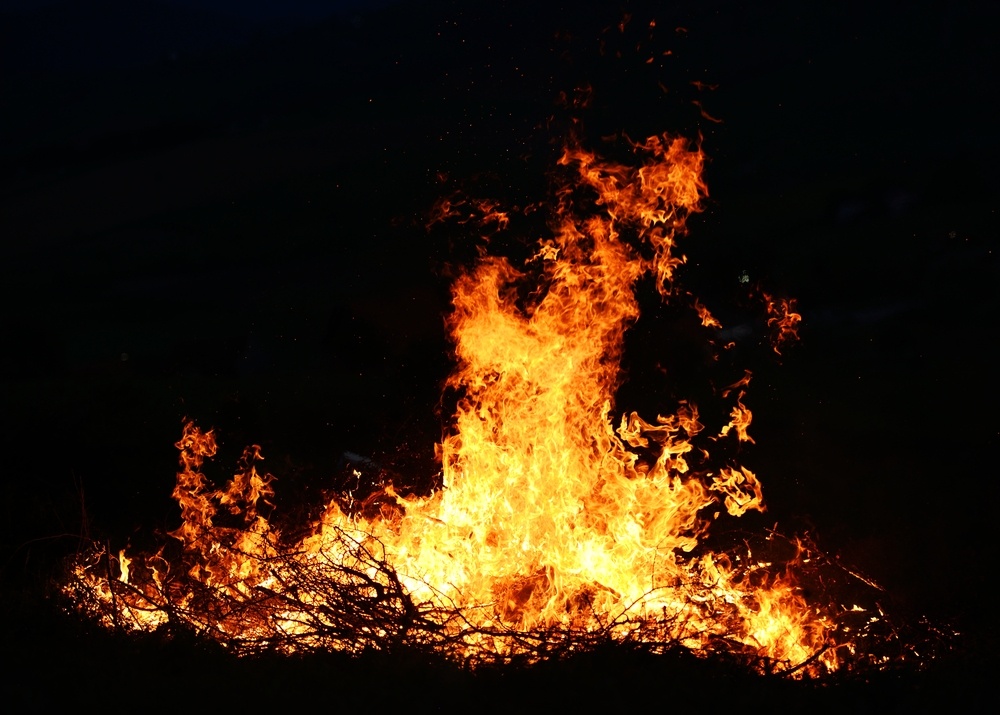Explore the health impact of wildfires and learn prevention strategies:
A thick, reddish smoke filled the sky, casting a fiery, dark hue. In the distance, a steady fire burned along the horizon, sending up glowing flames and more smoke. From afar, high-pitched, urgent bells rose and fell in a rhythmic pattern.

A home burns during the Corral Fire at Bernard and Stearman roads, west of Tracy, Calif., Saturday, June 1, 2024.
Amidst this scene, a fleeting shock surged through my heart. It was late afternoon in July, and I was driving on a heavily congested highway. The Fire had started the afternoon at Torrey Pines State Natural Reserve in San Diego, CA [1]
A month earlier, I had encountered a similar scenario when temperatures soared well above my body’s normal range. Although wildfires are not uncommon in western states during the summer, their frequency has increased in recent decades due to factors such as climate change, habitat destruction, and human activities. This rising trend in wildfire occurrences is a growing concern.
The effects of wildfires extend beyond immediate disruptions. For instance, being forced to stay indoors due to air pollution can negatively impact mood and daily life. Additionally, the environmental damage caused by wildfires can lead to serious chronic health issues and reduce overall longevity.[2]
This article aims to serve as a comprehensive health guide for individuals living in western states during the summer. It will explore the formation mechanisms of wildfires and the health impacts they pose. Furthermore, it will provide information on prevention and coping strategies to better manage the risks associated with wildfires.
How Wildfires Are Formed
Wildfires can occur naturally due to the sun's heat or lightning strikes. A wildfire happens when the “fire triangle”—composed of oxygen, heat, and fuel—comes together. Fire ignites when oxygen in the air interacts with a fuel source that is heated to its flash point.
Fuel can be any flammable material, such as trees, grasses, or shrubs. As these materials emit vapors, the heat raises them to their flash point, causing the vapor to mix with oxygen and undergo a chemical reaction known as combustion.[3]
Wildfires caused by Human Activities
Nearly 85 percent of wildfires in the United States are caused by human activities. Recreational activities can unintentionally contribute to wildfires through unattended campfires, sparks from machinery, and off-road activities that disturb vegetation.[3]
On a larger scale, deliberate land management and agricultural practices increase wildfire risks. These include deforestation, erosion prevention practices that leave excessive residues, and constructing faulty electrical systems.
Additionally, climate change—driven by activities such as burning fossil fuels—has intensified the wildfire problem. From 1990 to 2022, the area burned by wildfires grew significantly, with 7.6 million acres consumed in 2022 alone, more than doubling the amount burned since the 1990s.[4]
How Wildfires Impact Human Health
Wildfires produce smoke that contaminates the air with PM2.5 (particulate matter less than 2.5 micrometers), which can penetrate the respiratory system and lead to severe chronic diseases.[2]
Exposure to PM2.5 can result in reduced lung function, bronchitis, exacerbation of asthma, heart failure, and even premature death. Inhaling or coming into contact with wildfire smoke can also cause eye irritation and mild respiratory issues. Children, pregnant women, and the elderly are especially vulnerable to the adverse effects of this pollution.[2]

Prevention Strategies From Individual Perspectives
Addressing and reducing wildfires at their source is a key concern for public health. Individuals play a crucial role in minimizing the risk factors contributing to wildfires. Combustion requires the presence of three elements: oxygen, heat, and fuel; removing any of these elements can help prevent fires.
On an individual level, it's important to learn and practice safe behaviors, such as properly using outdoor equipment, burning debris safely, starting and extinguishing campfires correctly, maintaining vehicles, and towing safely. These measures help reduce the risk of accidental fires and contribute to overall wildfire prevention.
Safety Tips During A Wildfire
Before Wildfire Happens
-
Listen regularly to local alert systems, Weather Radio and EAS
-
Move Outdoor Furnitures and Equipments Inside
During & After Wildfires
-
Reduce and Avoid Outdoor Activities Durin
-
Close all vents, doors, and windows
-
Use a Portable air cleaner, if applicable
-
Wear N95 Respirator Masks When You Go Out
-
Stay informed
Call To Community Actions:
Following two of the most destructive and deadly years of wildfires, Governor Newsom took action to safeguard communities and establish a long-term approach to wildfire prevention and forest health.
This effort includes implementing vegetation management projects to reduce fire risks and improve forest resilience.
Governor Newsom addressed 35 priority projects in CAL FIRE that can be immediately implemented to help reduce safety risks for over 200 of California’s most wildfire-vulnerable communities.














